Rapport

Executive summary
Two storylines have dominated the Chinese business scene for the past two decades: the astonishing growth of the economy and the fierce battle for talent.
In an attempt to keep up with the earlier period of unprecedented growth in the economy throughout most of the 2000s, top business executives in China have dealt with recurring challenges regarding talent—where to find emerging leaders among the 7.5 million graduates of higher education institutions each year, how to take time out to develop those leaders in a fast-paced business environment, how to reward excellence, and how to fend off talent-poaching competitors and retain talent.
Many leaders and owners, surfing the waves of consistently spectacular growth in one sector after another, have seen revenue growing much faster than their talent’s ability to keep up.
Now, a new era in the Chinese economy is unfolding. As growth has settled at less than 7% for the economy as a whole, the growth rate in the industrial sector has started to decline while the service sector continues to show increased growth. This sea change presents a completely new management challenge in hiring and retaining top talent.
Along with the economy, the talent landscape has also changed in the past 20 years. Thousands of Chinese nationals have been learning and refining management skills in local and multinational companies. A younger, more tech-savvy generation that came of age in this new business environment has now joined this cohort.
The local entrepreneurial scene has also matured, no longer lagging a step behind the multinational companies that have built multibillion dollar businesses in China. Locally owned companies have upped their game in their internal talent-development programs, and their fast-growing operations present opportunities for China’s homegrown talent to build something they can take pride in.
The collective impact of these changing forces on the Chinese talent story has been profound, and it has created a distinct need for credible demographic data on the current group of business leaders.
Thanks to a partnership with LinkedIn China, Bain & Company has completed a study that provides powerful insight into the current generation of business leaders in China. The study equips those who recruit and manage business leaders in China with a greater understanding of who Chinese leaders are, where they work, what kinds of roles they have held, and how the talent of the future is evolving.
Stephen Shih, a partner with Bain's Organization practice, discusses the key trends that will affect Chinese companies in the coming years.
Approach
Bain & Company analyzed 25,000 individuals in LinkedIn China’s proprietary member database. This set of samples comes from 220 major corporations across 18 industries.
We selected those 18 industries because they represent both the manufacturing and service sectors of the economy. They are luxury goods, hotel, automotive, medical, energy, information and communications technology, airlines, public relations, food and beverage, industrial equipment, construction, finance, logistics, professional services, retail, media, Internet and legal (see Figure 1). There are two criteria for the 220 companies qualified across those industries: Each company has significant revenue and is a leading player in the industry, and each company has good employee representation on LinkedIn.
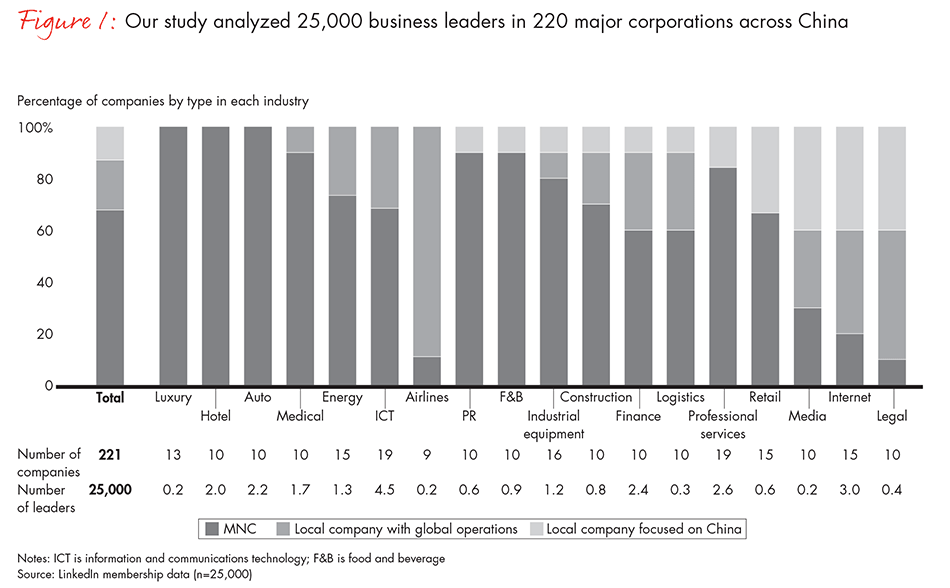
As defined by the criteria, these companies represent some of the world’s largest, with about 30% of the companies appearing in the Global Fortune 500 and around 15% in the Global Fortune 100.
This report is about leadership, so it focuses on individuals whose titles are director and above. We adjusted title conventions across industries and types of firms to accurately reflect the leaders in the sample.
Results of analysis
In a very rich set of data, we found numerous insights about the current generation of leaders in China. A snapshot of the broad characteristics of those sampled provides understanding of the distribution of leaders across gender, age, industry, education level and work experience.
Seven insights about China’s business leaders stand out from the assessment of the profiles in LinkedIn’s database:
- They are highly educated;
- They are globally minded;
- They are young;
- They are very mobile;
- Women leaders are critical;
- Digital leadership roles are quickly emerging; and
- Chinese leaders are taking on more regional roles in their firms.
They are highly educated
Post-graduate degrees are very common among Chinese business leaders. More than 60% of Chinese business leaders at the director level and above have advanced degrees, including master’s, MBAs and PhDs (see Figure 2). Leaders in multinational companies are twice as likely to hold MBA degrees, a trend for which there might be a number of causes. Those companies might prefer to hire candidates who already hold MBAs; MBAs might have a leg up in the skills and networking tactics that help one move up the ranks in multinational companies, or those companies might support current employees pursuing higher education during their tenure as part of a talent-development program.
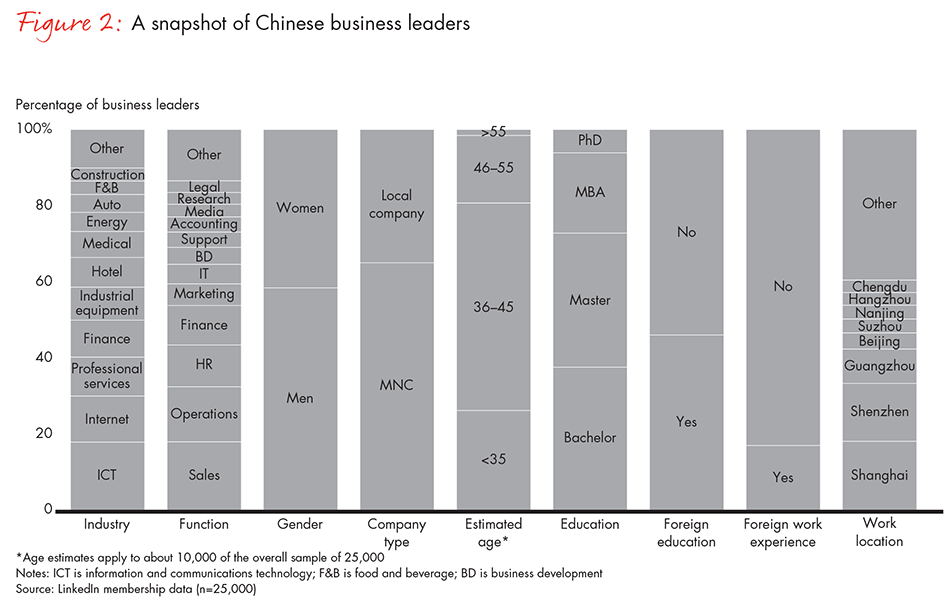
They are globally minded
In the sample set for this study, almost one in five Chinese business leaders have overseas work experience, but more than three in five leaders work for a multinational company with a major presence in China. In addition, about half have studied at a foreign school or university. Non-Chinese executives account for about 20% of the leadership at multinational companies—nearly twice as many as those at local companies. A larger proportion of leaders at multinational companies received a foreign education than those at locally owned firms (see Figure 3).
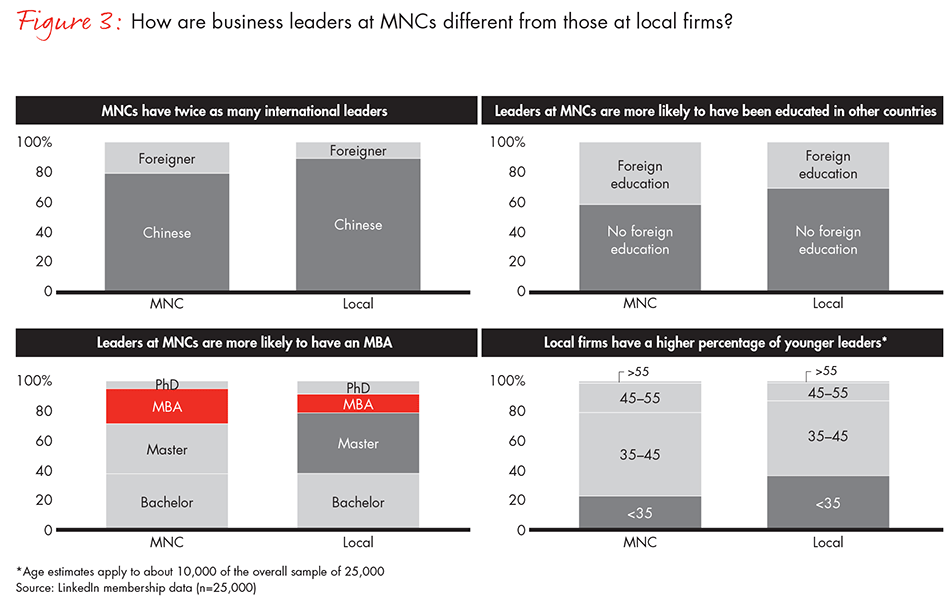
They are young
The average age of business leaders in the study is 39. This figure likely reflects the fact that LinkedIn’s user profile skews slightly younger, but it also reflects the accelerated growth in business activity and leadership opportunities in China in the past two decades. Local firms have more leaders under age 35 than multinational companies.
“Many 30-year-olds in Internet start-ups hold critical management responsibilities and lead an army of team members,” said Wayne Chen, senior vice president with ride-sharing company DiDi Chuxing. “With their passion and adaptable, innovative mindset, these younger executives have an unprecedented set of opportunities to polish their toolkit and grow as business leaders.”
They are very mobile
Conventional wisdom among human resources professionals says Chinese business leaders switch jobs frequently. The research confirms that observation: More than 40% of leaders have changed companies in the past five years, with more than half of those job-hoppers also entering completely new industries (see Figure 4).
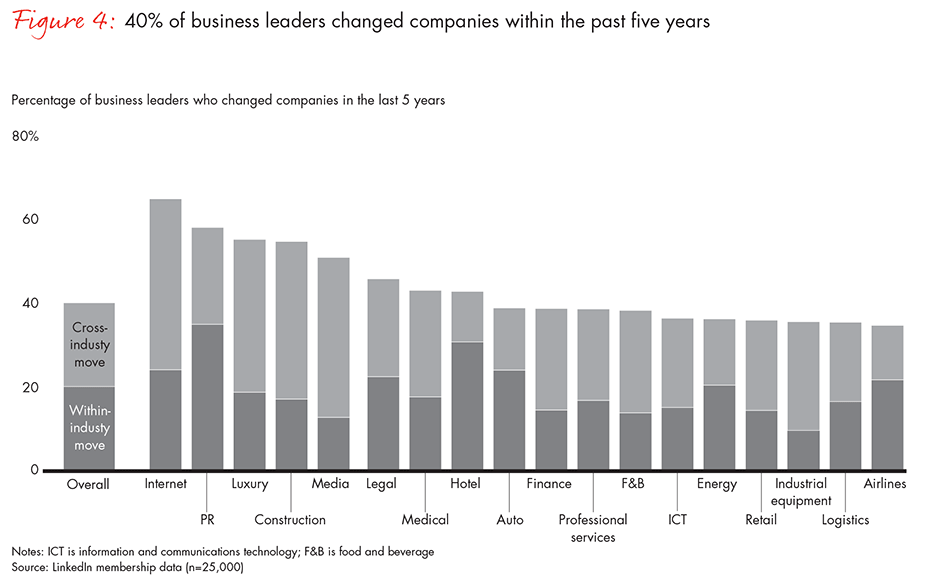
Talent wars appear to be even more intense among local companies, with more than 51% of leaders shifting companies in the past five years. But if local companies are concerned about losing talent to their local competitors, they may take solace in knowing that the flow of leaders between multinational companies and local firms is unbalanced in their favor. Human resources professionals and CEOs should note that only 10% of leaders in multinational companies came from local firms in the past five years, but almost one-third—31%—of leaders at local firms were employed at multinational companies within the past five years (see Figure 5). Many Chinese nationals are finding that local companies are scaling up their operations and now offer career growth opportunities that compete with the established multinational companies.
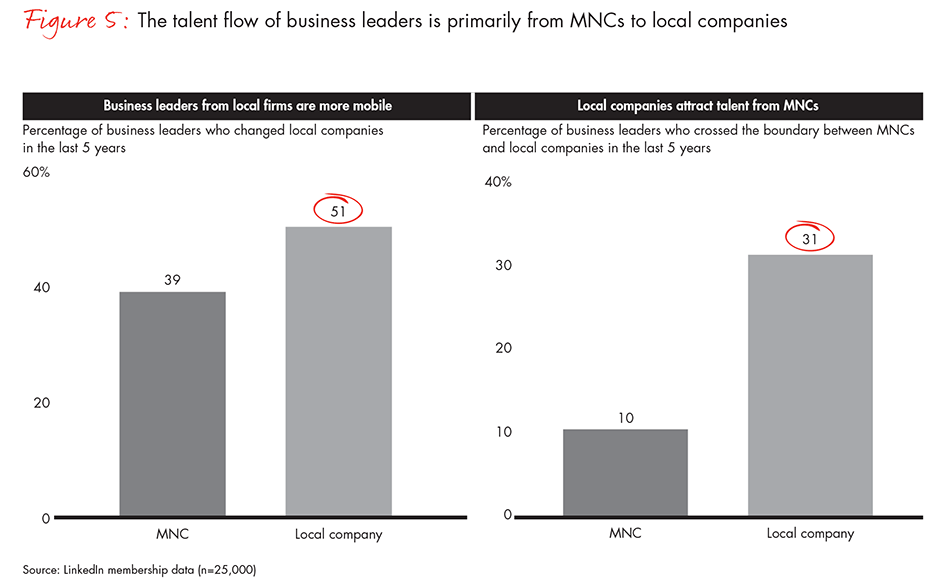
“The emergence of China as a global economic leader results in localization of human resources,” said Justin Luo, cofounder and CEO of Tujia, a China-based peer-to-peer online marketplace and home stay network. “People will continue to switch jobs to local companies.”
Some sources indicate that the trend of leaders moving from multinational companies to local firms will continue. Many local companies seek out leaders with experience at multinational companies because their training programs have a reputation for developing strong technical and managerial capabilities.
Charles Wang, vice president of Lenovo Group and chief marketing officer of Lenovo China, said he sees local companies becoming more attractive because they provide the opportunity to drive strategic changes and greater career development.
“The China business unit of a multinational company is often limited to following the ‘strategic direction’ developed at its headquarters,” Wang said. “At the same time, this flow of business executives from multinational firms strengthens local firms by offering more professional management skills and global experiences.”
The top three industries for job changes are Internet, public relations and luxury goods. The most stable industries with fewer cross-industry and company moves are airlines, logistics and industrial equipment.
LinkedIn provided additional insight in a separate study, which found that Chinese business professionals expect to leave their current positions significantly sooner than their US counterparts. Chinese professionals also switch industries more often than business professionals in North America.
Women leaders are critical
Women leaders are present in every industry in China. Overall, 40% of the leaders in the study were female, and among leaders under age 35, the study found an almost equal number of female and male leaders. Women leaders in China are younger than their male counterparts on average, as female representation wanes after age 35 and drops off sharply after age 45 (see Figure 6).
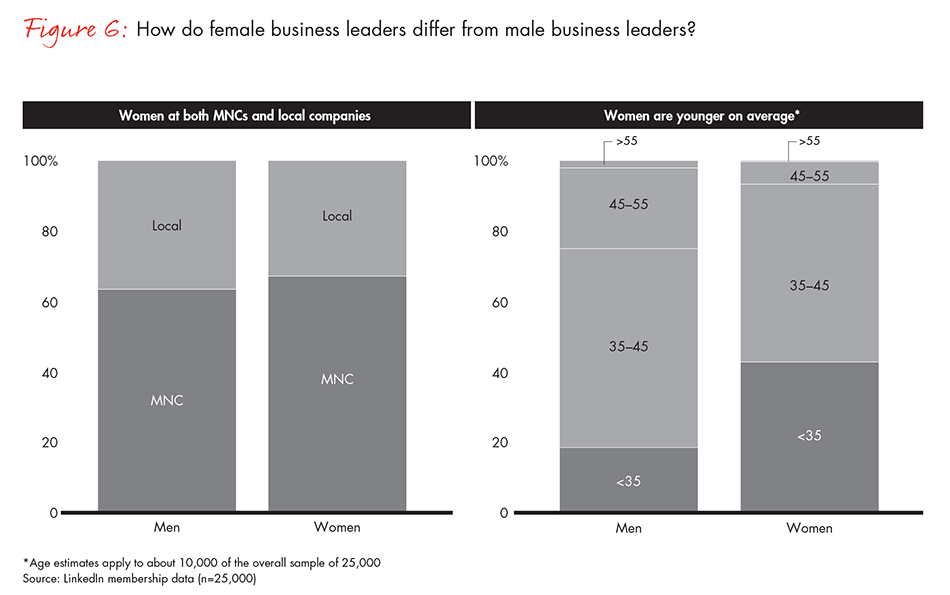
Rain Long, chief human resources officer and general counsel for JD Group, said she has observed a couple of particular strengths women executives bring to leading teams.
“They often employ a broader set of considerations for success, like collaboration and cooperation within their teams, resulting in stronger performance overall,” Long said. “And their intuition often leads them to better decisions when there is a lack of hard evidence and data.”
In each age group, women leaders are well represented across all functions in local and multinational companies, with a slight skew toward service functions such as human resources, legal work and administrative positions as well as a slight skew away from operations and engineering roles. Positions in sales, product management and marketing showed near parity between genders.
Those trends also hold true in the younger generation: Administrative, human resources, and media and communications are the top three job roles for young women leaders. The three roles with the lowest female representation are engineering, business development and operations (see Figure 7).
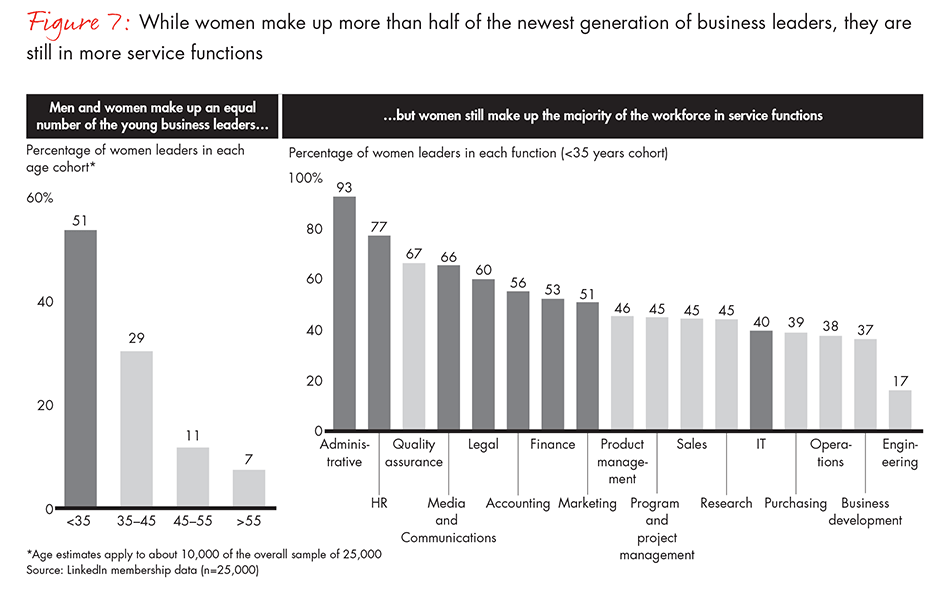
The share of women in director-level positions is also higher than the share in vice president or chief executive officer positions. Men occupy most of the positions across all three leadership levels, but the director level displays near parity, with 44% of directors being female. The share of women leaders drops significantly for the next steps up on the corporate ladder (see Figure 8).
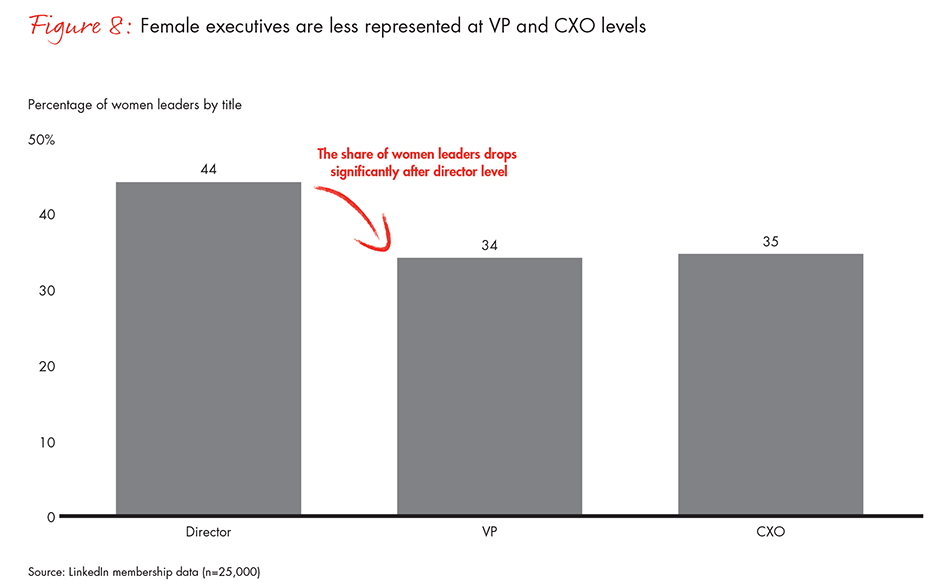
“There is great potential for women leaders in China because I believe in their intrinsic capabilities,” said Wayne Chen, with DiDi. “However, they have not had sufficient opportunities ‘at-bat’ to realize their full potential. This can be attributed to external reasons: the expected role they need to play in their family life and bias from the male executives in professional settings.”
Digital leadership roles are quickly emerging
Analysis of job titles shows that many industries are now adopting “digitization” with the emergence of leadership roles with “digital” responsibilities, including e-commerce, big data and online marketing.
This trend likely corresponds with Chinese consumers’ enthusiastic embrace of the digital world. In some sectors, more than 50% of purchase decisions are now made online in China, and 75% of consumers use the Internet to browse or purchase items. The business-to-business sector is also continuing to adopt digital technology, adding to the increase in digital transactions.
Setting aside Internet companies where “everyone is digital,” the study shows that on average 41% of companies now have leadership roles connected to the digital aspects of their business (see Figure 9). These roles include overseeing e-commerce, digital strategy, digital business, big data and information management, and online marketing. Leaders at the director level, but not yet in the C-suite, typically hold these roles. While nearly half of companies recognize the need for dedicated leaders in digital, those leaders make up only 1% of all Chinese business leaders.
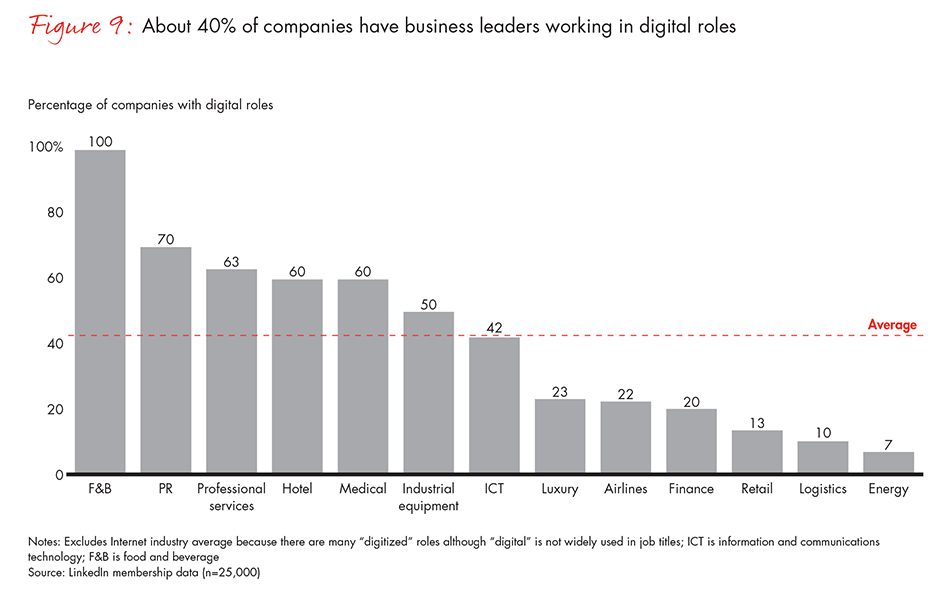
“One cannot win without new tech in China,” said Martin Kühl, a spokesman for Audi AG in Shanghai. “Audi began to cooperate with Alibaba 10 years ago. Beginning this year, we are starting to co-develop 3D maps and transportation big data.”
The top three industries embracing digital leadership are food and beverage, public relations and professional services. The three industries least likely to embrace digital leadership are energy, logistics and retail.
Although the study collected many interesting data points about the rise of digital roles, the limited sample size of digital leadership job titles means the observations are less concrete than other observations in this report. They indicate the direction the business world may be going in relation to digital trends, but do not provide a definitive statement about the current situation.
Chinese leaders are taking on more regional roles in their firms
As Chinese nationals gain more experience and the scale of Chinese operations increases, more Chinese leaders are expected to step up in their organizations. In the past decade, the number of Chinese firms listed on foreign stock exchanges has doubled. Among the top 100 Chinese companies with global operations, revenue and employees located abroad grew at rates of 70% and 130% respectively over the last five years.
Already, analysis shows that 5% of leadership roles in China are regional, ranging from supply chain and operations to engineering and sales.
“Ten years ago, director-level and above positions in multinational companies across China used to be mostly filled by foreign leaders, including executives from Hong Kong and Taiwan,” said Charles Wang, with Lenovo. “After 2012, we have seen more local leaders in the core management team as multinationals localize their China business. At the same time, local firms are expanding their global footprint.”
Within multinational companies in China, nearly 6 out of 10 regional roles are held by Chinese nationals, and nearly 9 out of 10 regional roles in local firms are held by Chinese nationals (see Figure 10). Overall, Chinese nationals hold about two-thirds of the regional leadership roles in the country.
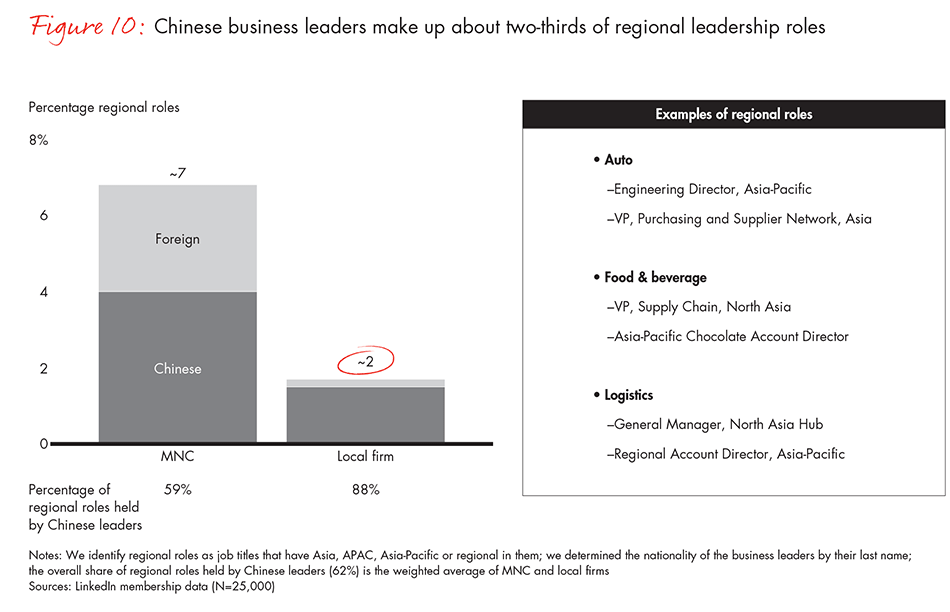
Conclusions and looking forward
Projecting the defining trend emerging from this study, we conclude that local firms will outperform multinational companies in the race for talent in the coming decade. Many of the next generation of Chinese leaders are demonstrating a preference for the steep learning curves and career trajectories that local companies provide over a perhaps more predictable path at a multinational. The multinational companies can no longer expect to win through their talent-development programs, salary and benefits packages or international assignment opportunities; scaled-up local companies now match them toe-to-toe. The uneven flow of leaders from multinational companies to local firms is unsustainable. Multinational companies that understand this data will rethink their structure, roles, value proposition and ways of working—and put all their experience to work in an effort to reverse the flow.
Ruobing Zhao, senior vice president of CreditEase, said the transition from multinational companies to local firms poses three challenges to business leaders in China.
“They must overcome cultural differences, adjust to less structured organizational processes and manage an increase in workload,” Zhao said. “Executives making this transition need to understand that multinational firms and local companies are at different stages of maturity so they can adapt and succeed in the new environment.”
Will this trend continue, or will MNCs respond with new strategies to retain their top leaders? We will watch this closely for future reports.
Another trend to watch involves women leaders. Will the younger generation continue to progress up the career ladder or, 20 years from now, will the presence of female leaders continue to drop off after age 35 as they transition into nonleadership positions?
The trend of dedicated digital leadership roles is also expected to continue to grow, penetrating some of the slower-to-adapt industries.
Finally, in keeping with the trend of local Chinese firms gaining more maturity and sophistication, we expect that Chinese leaders will take on more responsibility at both local and multinational firms. Our sources observe that the “glass ceiling” at multinational companies for Chinese nationals seems to be breaking as more locals take on roles at the director level or above within foreign firms. The global roles available at many multinational companies may continue to attract many of China’s globally minded and ambitious leaders.
Let’s remember that the next generation of business leaders is still young, so how the second chapters of their careers unfold is still to be seen.
Appendix
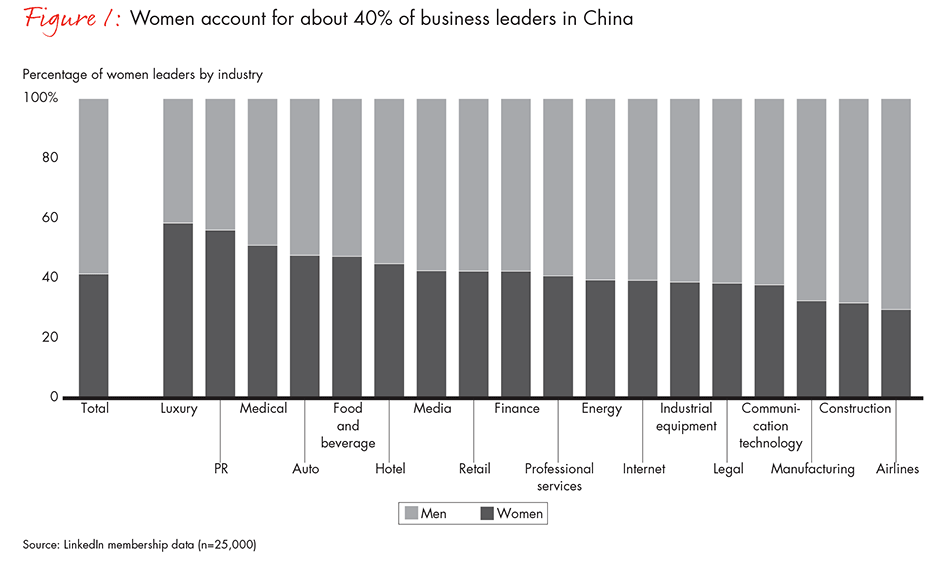
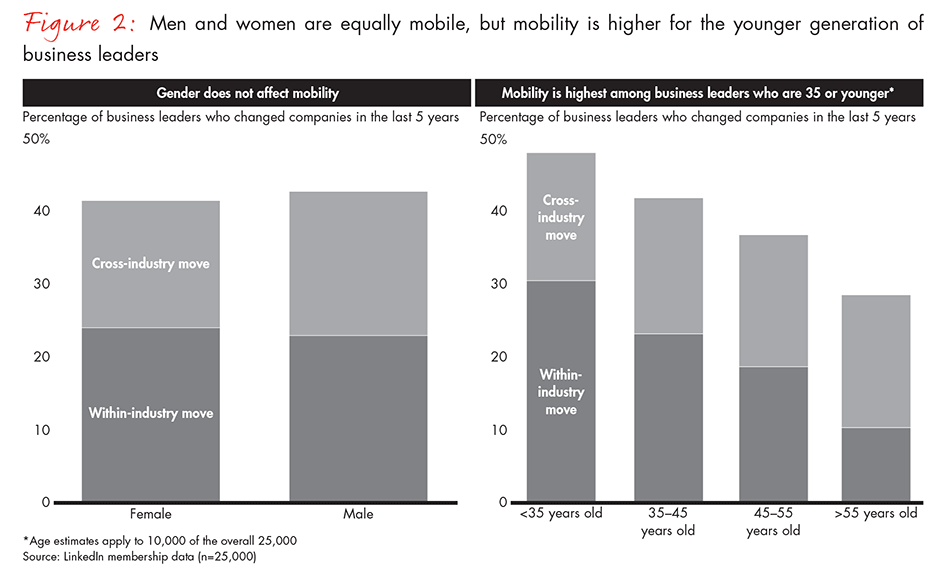
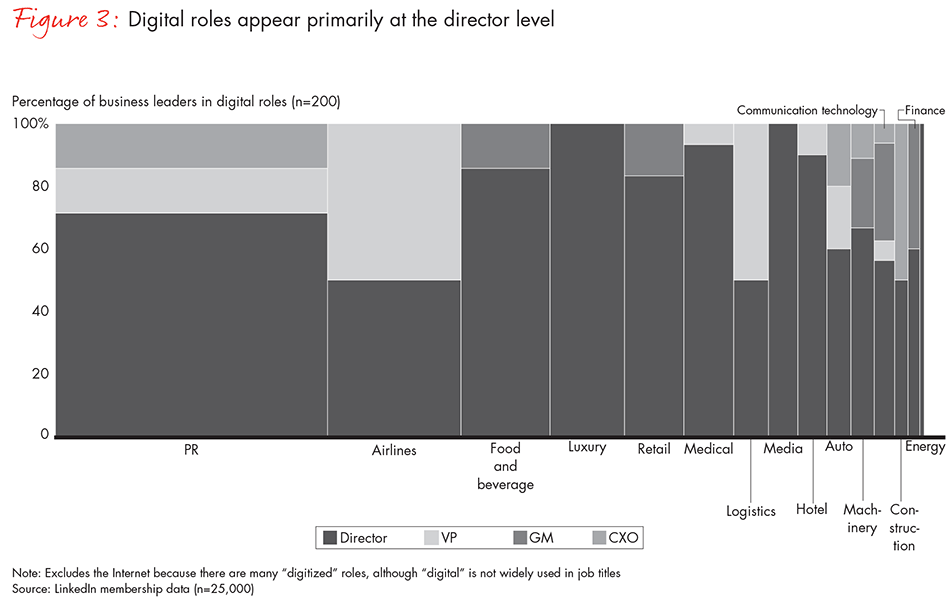
James Root is a partner with Bain & Company in the firm’s Hong Kong office. Stephen Shih is a Bain partner in Beijing. They are both leaders in the firm’s Organization practice. David Yu is Vice President of LinkedIn China. Brenda Chen is Director of B2B Marketing and Marketing Operations of LinkedIn China. As leaders of Corporate Business, they guided LinkedIn China Think Tank to complete this research and report.
Founded in May 2003, LinkedIn is the world’s largest professional network on the Internet. With more than 450 million members worldwide, LinkedIn covers 200 countries in 24 different languages. Every second, three new professionals become LinkedIn members. LinkedIn was listed as one of The Fortune Change the World companies due to its mission of connecting the world’s professionals to make them more productive and successful. LinkedIn strives to create economic opportunity for everyone in the global workforce, to help them achieve their full potential and develop the world’s first Economic Graph, a digital mapping of the global economy.
LinkedIn China Think Tank aims at providing strategic insights for decision makers in the talent industry, with the power of LinkedIn big data and the Internet. China LinkedIn Think Tank has actively responded to national policies and initiatives such as Made in China 2025, Inclusive Finance and Internet Plus, by publishing a series of exclusive data-driven industry talent reports such as Made in China Talent White Paper, China Internet Finance Talent White Paper and China Internet Top Position Talent Database Report. With big data analytics, LinkedIn talent reports have successfully presented industrial talent trends, regional talent mobility and cross-country talent comparisons, winning recognition from mainstream media.












